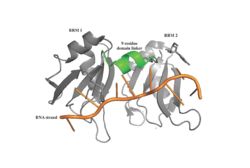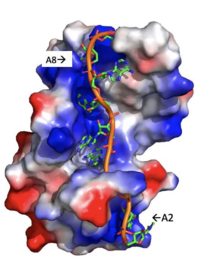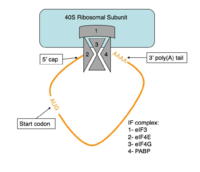Poly(A) binding protein
From Proteopedia
(Difference between revisions)
| (5 intermediate revisions not shown.) | |||
| Line 3: | Line 3: | ||
<StructureSection load='1cvj' size='340' side='center' caption='' scene='78/781947/Rnp_1_rnp2/7'> | <StructureSection load='1cvj' size='340' side='center' caption='' scene='78/781947/Rnp_1_rnp2/7'> | ||
| - | + | ||
| - | + | ||
==Introduction== | ==Introduction== | ||
| Line 16: | Line 15: | ||
[[Image: Screen_Shot_2018-03-29_at_12.18.14_AM.png|250 px|left|thumb|Figure 2: The specific weak intermolecular interactions between RNP1 and RNP2 and adenosines. These interactions are the primary support of adenosine recognition by PABP and include mainly van der Waals interactions, hydrogen bonds, and stacking interactions. ]] | [[Image: Screen_Shot_2018-03-29_at_12.18.14_AM.png|250 px|left|thumb|Figure 2: The specific weak intermolecular interactions between RNP1 and RNP2 and adenosines. These interactions are the primary support of adenosine recognition by PABP and include mainly van der Waals interactions, hydrogen bonds, and stacking interactions. ]] | ||
| - | A primary function of PABP is recognizing and interacting with the 3' Poly(A) tail created in mRNA processing. As found by [https://en.wikipedia.org/wiki/Electrophoretic_mobility_shift_assay EMSA competition experiments], there are a minimum of 11-12 adenosines necessary in the Poly(A) tail for the adenosine chain to bind to PABP with high affinity. However, for one biological assembly, a chain containing 9 adenosines sufficiently binds the assembly for [https://en.wikipedia.org/wiki/Crystallization crystallization] and is shown in the biological assembly structure. The 4 RRMs that are the primary interacting sites for the adenosine recognition exist as globular domains, each having four antiparallel [https://en.wikipedia.org/wiki/Beta_sheet β-strands] (labeled S1-S4) and two [https://en.wikipedia.org/wiki/Alpha_helix α-helices] (labeled H1 and H2). The strands are spatially arranged as S2-S3-S1-S4, and the two inner strands create vital interactions with the Poly(A) tail. There are two [https://en.wikipedia.org/wiki/Conserved_sequence conserved sequences] in each RRM, called RNP1 and 2. RNP 1 consists of a conserved sequence of 8 [https://en.wikipedia.org/wiki/Residue residues], while RNP2 consists of a conserved sequence of 6 residues. Much of the weak [https://en.wikipedia.org/wiki/Intermolecular_force intermolecular interactions] with [https://en.wikipedia.org/wiki/Adenosine adenosine] from the RRMs occur from the <scene name='78/781946/Rnp_1_rnp2/1'>RNP 1 and RNP 2</scene> conserved sequences, which correspond to the two central β-strands, with specific interactions shown in Figure 2. The support for adenosine recognition by the RRMs occurs as a type of binding trough with the sheets, primarily | + | A primary function of PABP is recognizing and interacting with the 3' Poly(A) tail created in mRNA processing. As found by [https://en.wikipedia.org/wiki/Electrophoretic_mobility_shift_assay EMSA competition experiments], there are a minimum of 11-12 adenosines necessary in the Poly(A) tail for the adenosine chain to bind to PABP with high affinity. However, for one biological assembly, a chain containing 9 adenosines sufficiently binds the assembly for [https://en.wikipedia.org/wiki/Crystallization crystallization] and is shown in the biological assembly structure. The 4 RRMs that are the primary interacting sites for the adenosine recognition exist as globular domains, each having four antiparallel [https://en.wikipedia.org/wiki/Beta_sheet β-strands] (labeled S1-S4) and two [https://en.wikipedia.org/wiki/Alpha_helix α-helices] (labeled H1 and H2). The strands are spatially arranged as S2-S3-S1-S4, and the two inner strands create vital interactions with the Poly(A) tail. There are two [https://en.wikipedia.org/wiki/Conserved_sequence conserved sequences] in each RRM, called RNP1 and 2. RNP 1 consists of a conserved sequence of 8 [https://en.wikipedia.org/wiki/Residue residues], while RNP2 consists of a conserved sequence of 6 residues. Much of the weak [https://en.wikipedia.org/wiki/Intermolecular_force intermolecular interactions] with [https://en.wikipedia.org/wiki/Adenosine adenosine] from the RRMs occur from the <scene name='78/781946/Rnp_1_rnp2/1'>RNP 1 and RNP 2</scene> conserved sequences, which correspond to the two central β-strands, with specific interactions shown in Figure 2. The support for adenosine recognition by the RRMs occurs as a type of binding trough with the sheets, primarily RNP 1 and RNP 2 forming the base of the primary binding trough, and the interstrand loop between β-strands 2 and 3 as well as the domain linker forming the <scene name='78/781947/Adenosine_binding_wall/1'>Adenosine Binding Wall</scene>. It is believed that the <scene name='78/781946/Pabp_linker_conserved_residues/1'>Conserved Linker Shown</scene> is disordered in the absence of RNA because it does not intramolecularly interact with either of the RRM motifs, and instead only interacts with the RNA such as with Arg 94 exhibiting pi-stacking with Adenosine-6 and side chain hydrophobic interactions with Adenosine-5. The primary binding trough is stabilized by <scene name='78/781947/Rrm1_2_packing_intxn/3'>Stabilizing Packing Interactions of RRM1 RRM2 Binding Trough</scene>. <ref name= "PABP"/> |
[[Image: Adenosine_backbone.png |200 px|right|thumb|Figure 3: Basic residues of RRM 1 and 2 (shown in blue) make stabilizing electrostatic interactions with the negatively charged phosphate backbone. ]] | [[Image: Adenosine_backbone.png |200 px|right|thumb|Figure 3: Basic residues of RRM 1 and 2 (shown in blue) make stabilizing electrostatic interactions with the negatively charged phosphate backbone. ]] | ||
| Line 35: | Line 34: | ||
====Structural Components of PABP Translation Initiation==== | ====Structural Components of PABP Translation Initiation==== | ||
| - | [[Image:Figure_4.png | + | [[Image:Figure_4.png|200 px|left|thumb|Figure 5:Conserved residues that potentially bind regulatory proteins and translation initiation factors.]] |
| - | The RRMs support interactions with the interacting proteins such as eIF4G and [https://en.wikipedia.org/wiki/PAIP1 PAIP-1], however, the specific ways in which PABP interacts with these proteins are not structurally proven. However, there is a convex dorsal surface present on the RRM 1 and 2 motifs formed by the two α-helices in each RRM, specified as H1 and H2 in RRM1 and H1' and H2' in RRM2. This surface contains a sequence portion of <scene name='78/781947/H1_and_h2_h2ophobic_residues/4'>conserved hydrophobic residues</scene> and <scene name='78/781947/Hydrophilic_residues/3'>conserved hydrophilic residues</scene>. It is thought that this area of conservation thus produces overlapping binding sites to interact with eIF4G and PAIP-1. The conserved acidic residues may be beneficial to be used in order to interact with essential basic residues present in both eIF4G and PAIP-1 via ionic interactions <ref name="PABP"/>. | + | The RRMs support interactions with the interacting proteins such as eIF4G and [https://en.wikipedia.org/wiki/PAIP1 PAIP-1], however, the specific ways in which PABP interacts with these proteins are not structurally proven. However, there is a convex dorsal surface present on the RRM 1 and 2 motifs formed by the two α-helices in each RRM, specified as H1 and H2 in RRM1 and H1' and H2' in RRM2. This surface contains a sequence portion of <scene name='78/781947/H1_and_h2_h2ophobic_residues/4'>conserved hydrophobic residues</scene> and <scene name='78/781947/Hydrophilic_residues/3'>conserved hydrophilic residues</scene>. It is thought that this area of conservation thus produces overlapping binding sites to interact with eIF4G and PAIP-1. Some of the most highly conserved residues can be seen in the LOGO diagram shown in Figure 5. The conserved acidic residues may be beneficial to be used in order to interact with essential basic residues present in both eIF4G and PAIP-1 via ionic interactions <ref name="PABP"/>. |
While there are only proposed mechanisms for how PABP promotes the initiation of translation in Homo sapiens, the mechanism is better understood in a pathogenic [https://en.wikipedia.org/wiki/Protozoa protozoan], Leishmania. Osvaldo P. de Melo Neto et. al found that an eIF4F-like complex [https://en.wikipedia.org/wiki/Phosphorylation phosphorylates] a site on the domain linker of a PABP homolog, PABP-1, at either serine-proline or threonine-proline residues.The authors suggest that this phosphorylation is part of how PABP-1 aids the eIF4F complex in initiating translation. They supported this by removing the gene that encodes PABP-1 and the results showed that the protozoan could not initiated cell growth and therefore survive without the PABP-1 gene. The homo sapiens' PABP also contain a (<scene name='78/781947/Pro-ser_in_linker/2'>Serine-Proline</scene>) site on the domain linker which could be interacting with the eIF4 complex in a similar way as in Leishmania protozoan <ref name="Osvaldo">De Melo Neto, Osvaldo P., et al. “Phosphorylation and Interactions Associated with the Control of the Leishmania Poly-A Binding Protein 1 (PABP1) Function during Translation Initiation.” RNA Biology, 23 Mar. 2018, pp. 1–17., doi:10.1080/15476286.2018.1445958.</ref>. | While there are only proposed mechanisms for how PABP promotes the initiation of translation in Homo sapiens, the mechanism is better understood in a pathogenic [https://en.wikipedia.org/wiki/Protozoa protozoan], Leishmania. Osvaldo P. de Melo Neto et. al found that an eIF4F-like complex [https://en.wikipedia.org/wiki/Phosphorylation phosphorylates] a site on the domain linker of a PABP homolog, PABP-1, at either serine-proline or threonine-proline residues.The authors suggest that this phosphorylation is part of how PABP-1 aids the eIF4F complex in initiating translation. They supported this by removing the gene that encodes PABP-1 and the results showed that the protozoan could not initiated cell growth and therefore survive without the PABP-1 gene. The homo sapiens' PABP also contain a (<scene name='78/781947/Pro-ser_in_linker/2'>Serine-Proline</scene>) site on the domain linker which could be interacting with the eIF4 complex in a similar way as in Leishmania protozoan <ref name="Osvaldo">De Melo Neto, Osvaldo P., et al. “Phosphorylation and Interactions Associated with the Control of the Leishmania Poly-A Binding Protein 1 (PABP1) Function during Translation Initiation.” RNA Biology, 23 Mar. 2018, pp. 1–17., doi:10.1080/15476286.2018.1445958.</ref>. | ||
Current revision
Poly(A) binding protein
| |||||||||||





